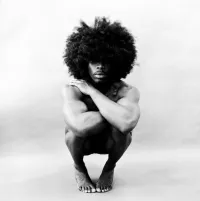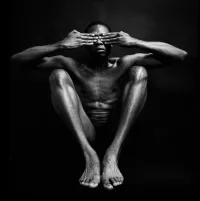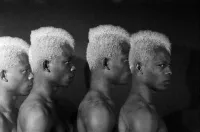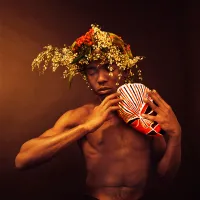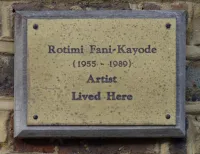Biography
1955 - 1989
“On three counts I am an outsider: in matters of sexuality; in terms of geographical and cultural dislocation; and in the sense of not having become the sort of respectably married professional my parents might have hoped for.”
– Rotimi Fani-Kayode
Rotimi Fani-Kayode was born to a prominent family in Lagos, Nigeria, on April 20, 1955. At age twelve his family moved to Brighton, England as political exiles to escape the Nigerian Civil War. He received his secondary education at private British schools. Moving to the USA in 1976, he got a degree at Georgetown University before continuing to get his MFA in Fine Arts and Photography at the Pratt Institute in Brooklyn. While there he became friendly with photographer Robert Mapplethorpe, who would be a large influence on his work. In 1983, shortly after graduation, Fani-Kayode returned to the Britain to explore his art further. In his often theatrical photography, Fani-Kayode explored homoeroticism, identity, myth, and spirituality, uniquely blending African and Western culture. Though he had fled his Yoruba culture as a boy, the images remained a large part of his identity and work. “Black, African, homosexual photography” was how he described his art. Fani-Kayode is best known for his series of single figure photographs, often of himself, adorned with paint, feathers and flowers, and performing what appear to be rituals. These photos are often seen as an attempt to reconcile the conflicting influences of his Yoruba background and his gay identity. His publications, often done in collaboration with his partner, photographer/filmmaker Alex Hirst, include Communion (1986) and Black Male/White Male (1987). In 1987 Fani-Kayode became a founding member and the first Chair of Autograph BP, an association of black photographers, and he was also active in the Black Audio Film collective. Like many artists who were suffering from AIDS, he also addressed his illness directly in his work. Fani-Kayode’s brilliant career lasted a mere six years and ended when he died of a heart attack on December 12, 1989 at age 34 in a London hospital while recovering from an AIDS-related illness. He was survived by Hirst who died of AIDS in 1994.
1955 - 1989
“On three counts I am an outsider: in matters of sexuality; in terms of geographical and cultural dislocation; and in the sense of not having become the sort of respectably married professional my parents might have hoped for.”
– Rotimi Fani-Kayode
Rotimi Fani-Kayode was born to a prominent family in Lagos, Nigeria, on April 20, 1955. At age twelve his family moved to Brighton, England as political exiles to escape the Nigerian Civil War. He received his secondary education at private British schools. Moving to the USA in 1976, he got a degree at Georgetown University before continuing to get his MFA in Fine Arts and Photography at the Pratt Institute in Brooklyn. While there he became friendly with photographer Robert Mapplethorpe, who would be a large influence on his work. In 1983, shortly after graduation, Fani-Kayode returned to the Britain to explore his art further. In his often theatrical photography, Fani-Kayode explored homoeroticism, identity, myth, and spirituality, uniquely blending African and Western culture. Though he had fled his Yoruba culture as a boy, the images remained a large part of his identity and work. “Black, African, homosexual photography” was how he described his art. Fani-Kayode is best known for his series of single figure photographs, often of himself, adorned with paint, feathers and flowers, and performing what appear to be rituals. These photos are often seen as an attempt to reconcile the conflicting influences of his Yoruba background and his gay identity. His publications, often done in collaboration with his partner, photographer/filmmaker Alex Hirst, include Communion (1986) and Black Male/White Male (1987). In 1987 Fani-Kayode became a founding member and the first Chair of Autograph BP, an association of black photographers, and he was also active in the Black Audio Film collective. Like many artists who were suffering from AIDS, he also addressed his illness directly in his work. Fani-Kayode’s brilliant career lasted a mere six years and ended when he died of a heart attack on December 12, 1989 at age 34 in a London hospital while recovering from an AIDS-related illness. He was survived by Hirst who died of AIDS in 1994.
Demography
Demography
Gender Male
Sexual Orientation Gay
Gender Identity Cisgender
Ethnicity Black
Nations Affiliated Nigeria United Kingdom United States
Era/Epoch AIDS Era (1980-present) Information Age (1970-present)
Field(s) of Contribution
Photography
World History
Demography
Gender Male
Sexual Orientation Gay
Gender Identity Cisgender
Ethnicity Black
Nations Affiliated Nigeria United Kingdom United States
Era/Epoch AIDS Era (1980-present) Information Age (1970-present)
Field(s) of Contribution
Photography
World History
Resources
Resources
Anthologie de la Photographie africaine et de l'Océan Indien XIXe & XXe siècles. Paris: Editions Revue Noire, 1998. 290-293.
Fani-Kayode, Rotimi. "Traces of Ecstasy." Reading the Contemporary: African Art from Theory to the Marketplace. London: Institute of International Visual Arts; Cambridge, Mass.: MIT Press, 1999. 276-281.
Hirst, Alex. "Introduction." Black Male/White Male: Photographs by Rotimi Fani-Kayode. London, Gay Men's Press: 1988. 3.
Mercer, Kobena. "Mortal Coil: Eros and Diaspora in the Photographs of Rotimi Fani-Kayode." Over Exposed:Essays on Contemporary Photography. Carol Squiers, ed. New York: New Press, 1999.
Oguibe, Olu. "Finding a Place: Nigerian Artists in the Contemporary Art World." Art Journal 58.2 (Summer 1999): 30-41.
Reid, Mark A. "Postnegritude Reappropriation and the Black Male Nude: The Photography of Rotimi Fani- Kayode." The Passionate Camera: Photography and Bodies of Desire. Deborah Bright, ed. London and New York: Routledge, 1998. 216-228.
Zaya, Octavio. "On Three Counts I Am an Outsider." Nka: Journal of Contemporary African Art. No. 4 (Spring-Summer 1996): 24-29.
Zaya, Octavio. "Rotimi Fani-Kayode." In/sight: African Photographers, 1940 to the Present. Clare Bell et al., eds. New York: Guggenheim Museum, 1962. 262.
http://en.wikipedia.org/wiki/Rotimi_Fani-Kayode
https://www.guggenheim.org/artwork/artist/rotimi-fani-kayode
https://visualaids.org/artists/rotimi-fani-kayode
Resources
Anthologie de la Photographie africaine et de l'Océan Indien XIXe & XXe siècles. Paris: Editions Revue Noire, 1998. 290-293.
Fani-Kayode, Rotimi. "Traces of Ecstasy." Reading the Contemporary: African Art from Theory to the Marketplace. London: Institute of International Visual Arts; Cambridge, Mass.: MIT Press, 1999. 276-281.
Hirst, Alex. "Introduction." Black Male/White Male: Photographs by Rotimi Fani-Kayode. London, Gay Men's Press: 1988. 3.
Mercer, Kobena. "Mortal Coil: Eros and Diaspora in the Photographs of Rotimi Fani-Kayode." Over Exposed:Essays on Contemporary Photography. Carol Squiers, ed. New York: New Press, 1999.
Oguibe, Olu. "Finding a Place: Nigerian Artists in the Contemporary Art World." Art Journal 58.2 (Summer 1999): 30-41.
Reid, Mark A. "Postnegritude Reappropriation and the Black Male Nude: The Photography of Rotimi Fani- Kayode." The Passionate Camera: Photography and Bodies of Desire. Deborah Bright, ed. London and New York: Routledge, 1998. 216-228.
Zaya, Octavio. "On Three Counts I Am an Outsider." Nka: Journal of Contemporary African Art. No. 4 (Spring-Summer 1996): 24-29.
Zaya, Octavio. "Rotimi Fani-Kayode." In/sight: African Photographers, 1940 to the Present. Clare Bell et al., eds. New York: Guggenheim Museum, 1962. 262.
http://en.wikipedia.org/wiki/Rotimi_Fani-Kayode
https://www.guggenheim.org/artwork/artist/rotimi-fani-kayode
https://visualaids.org/artists/rotimi-fani-kayode

